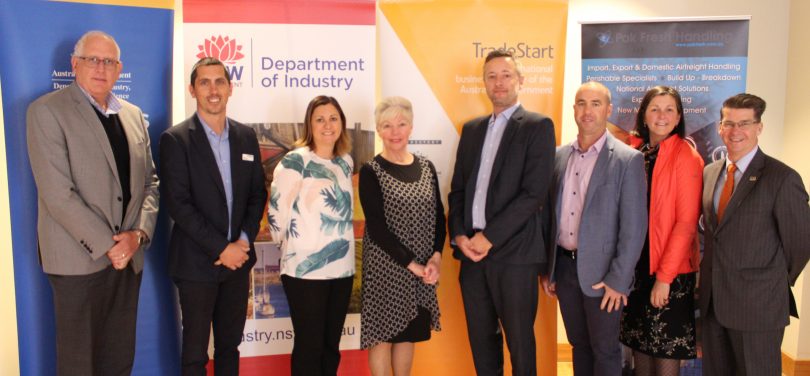
Peter Masterson – AusIndustry, Daniel Murphy – Economic Development Manager BVSC, Cr Kristy McBain – Mayor, Bega Valley Shire, Dianne Tipping – Export Council of Australia, Rory McAlester – TradeStart NSW, Adam Wright – Pak Fresh, Gabbie Cusack – Canberra Region Joint Organisation, Brendan Smyth – ACT Government. Photo: Ian Campbell.
Potential export businesses at Yass, Bega, Moruya, and Young have been invited to think big and expand their customer base beyond local shores.
Four workshops have been delivered, a partnership between Tradestart NSW, Canberra Airport, Pakfresh, the Export Council of Australia, AusIndustry, and the Canberra Region Joint Organisation of councils.
In Bega, questions came from existing businesses wanting to develop export markets in skincare, fresh oysters and meat – even locally produced lasagna meals.
And while realistic about the challenges and work needed to create an export business – the experts gathered were encouraging and supportive.
“Once you work through the processes it’s very doable, and it adds value to your product,” Dianne Tipping, Chair of the Export Council of Australia says.
Ms Tipping says the Export Council is keen to help make the process simple for regional produces and sees value in producers working together to scale up production, provide infrastructure, and support each other.
She also advises “don’t just concentrate on China.”
“ASEAN (Association of Southeast Asian Nations) has a bigger population and the same growing middle class.”
One of the key reasons behind the export conversation in the Canberra region is the new Pak Fresh perishable exports handling facility at Canberra Airport – with links to Singapore, Doha and domestic markets via Singapore Airlines, Quatar Airways, and Virgin Australia.
Adam Wright, Director of Pak Fresh says 20 to 25 tonnes of cargo space flies out of Canberra each day via the international carriers.
“We want to get things moving, we are ready to go with regional exports,” Mr Wright says.
“We can have it on the plane at 11 pm Canberra time and it is in Singapore early the next morning.”
Brendan Smyth, Commissioner of International Engagement, ACT Government say Canberra Airport has plans to expand its export/import operations and regional communities around the ACT are key to its success.
“The region gives us volume, the ACT doesn’t have enough fresh produce, and Canberra presents a number of advantages for regional exporters over Sydney and Melbourne airports – we are just two and a half hours away for a start,” he says.
“You can harvest and have it on the plane that same day.”
Mr Smyth points to the potential for regional communities, “Singapore imports 95% of its fresh produce, Japan imports 62% of its calories.”
“They really do look at us (Australia) as clean, green suppliers, it’s a big selling point.”
But he adds, trade in many Asian markets needs to be seen as a relationship rather than a business transaction.
“They want to know you are here for the long haul,” he says.
“And they want to know about you and want you to know about them, don’t just talk business, you need to experience their culture.”
While talk of building an export business is exciting the final advice for those gathered was black and white business.
“Understand the costs and see if it’s viable,” Ms Tipping says.







